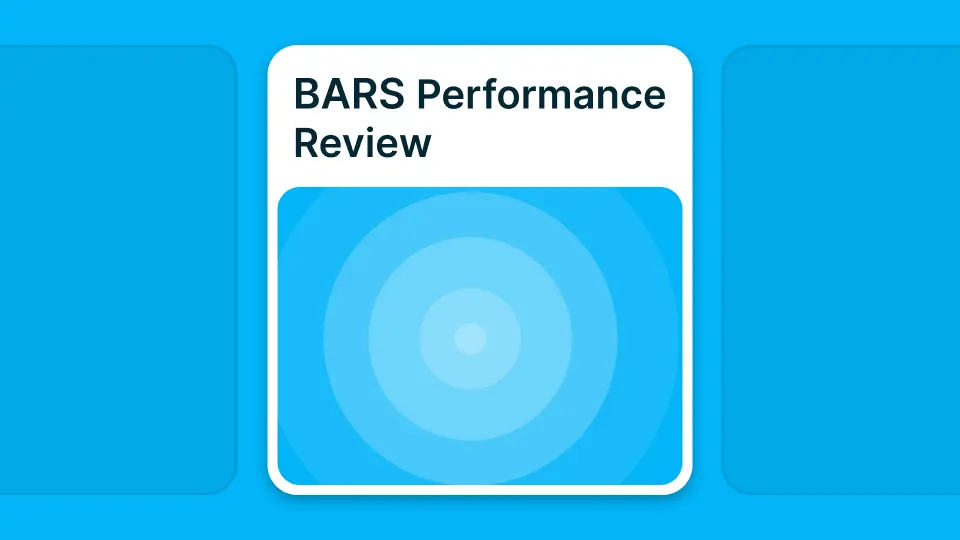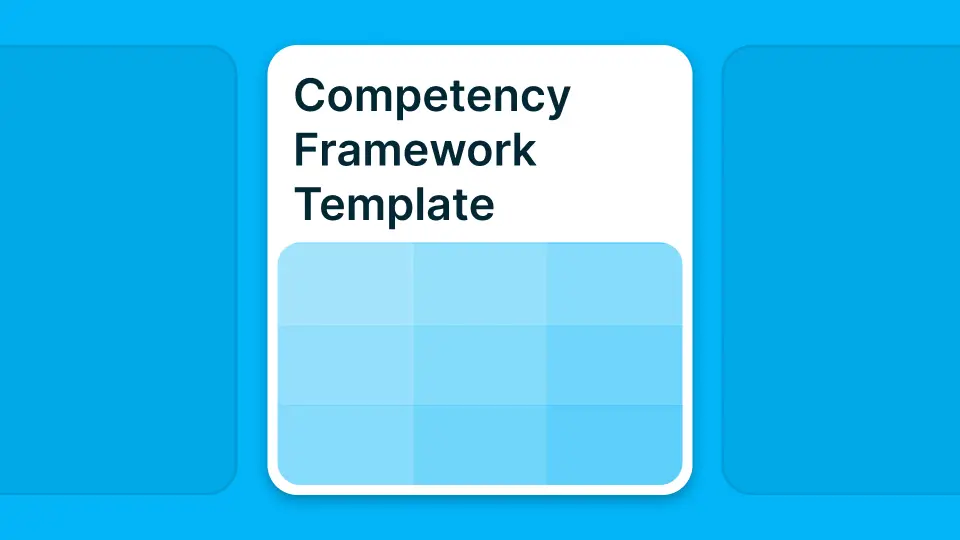A software purchase gone wrong doesn't just waste budget—it derails your entire performance strategy. You've seen it happen: months into implementation, critical features are missing, integrations fail, and adoption plummets. The root cause? An incomplete RFP that missed essential requirements from the start.
This guide delivers a complete, battle-tested RFP template specifically for performance management platforms. You'll get modular requirements checklists covering everything from 1:1s to AI assistants, a customizable scoring matrix weighted for different company sizes, demo scripts that reveal true capabilities, and vendor questions that separate genuine partners from pretenders. No more guesswork—just a clear roadmap to confident selection.
Here's what you'll find inside:
- Comprehensive requirements checklist broken down by feature module (reviews, feedback, goals, skills, analytics)
- Integration and security essentials including HRIS, SSO, GDPR compliance
- Weighted scoring matrix with recommendations for 50, 200, and 500-employee organizations
- Demo script scenarios and data migration checklist to validate vendor claims
- TCO breakdown covering hidden costs beyond license fees
- Due diligence questions that reveal vendor stability and roadmap alignment
Let's build an RFP that actually protects your investment and drives measurable results.
1. Defining Your Performance Management Needs: Requirements Checklist by Module
Start with a structured breakdown of features by module. This approach ensures every stakeholder's needs are documented—from frontline managers conducting 1:1s to HR leaders analyzing engagement data. According to research from the Human Capital Institute, 80% of failed implementations traced back to missing at least one critical module during the requirements phase.
Companies using comprehensive requirements lists see 30% faster time-to-value post-implementation. The difference? They identified gaps before signing contracts, not after go-live when fixes cost exponentially more.
Consider a global tech firm with 200 employees that skipped skills mapping in their RFP. Six months post-launch, they realized they couldn't track competency development or identify upskilling opportunities. Employee engagement scores dropped, and they spent another year implementing a separate skills platform—doubling their total investment.
Build your performance management software RFP template around these core modules:
- Map all required modules: 1:1 meeting management, performance review cycles, calibration sessions, 360° feedback, goals and OKRs, competencies and skills frameworks, career pathing and internal mobility, analytics and reporting, AI assistant capabilities
- Collect input from HR, department managers, and employee representatives to capture cross-functional needs
- Prioritize modules based on business strategy—growth companies need robust OKR tracking, while established enterprises may prioritize succession planning
- Use a structured table to distinguish must-haves from nice-to-haves, avoiding scope creep during vendor selection
- Validate your checklist against current pain points and three-year strategic plans
Your requirements checklist should follow this format:
| Module | Must-Have | Nice-to-Have | Not Needed | Notes |
|---|---|---|---|---|
| 1:1 Meetings | X | AI-generated agendas preferred | ||
| Performance Reviews | X | Multi-cycle support required | ||
| Calibration Sessions | X | Cross-department comparison | ||
| 360° Feedback | X | Peer nomination workflow | ||
| Goals/OKRs | X | Alignment visualization | ||
| Skills Mapping | X | 32,000+ skills taxonomy | ||
| Career Paths | X | Internal mobility tracking | ||
| Analytics Dashboard | X | Real-time reporting | ||
| AI Assistant | X | Predictive insights preferred |
Don't assume vendors define modules identically. One platform's "performance reviews" might exclude continuous feedback, while another bundles it automatically. Request detailed feature lists for each module during the RFP process, and map them against your specific workflow requirements.
For skills mapping specifically, verify whether the platform includes a comprehensive taxonomy or requires manual skill creation. Building a skills framework from scratch can add 3-6 months to implementation timelines. Platforms offering pre-built taxonomies with 30,000+ validated skills dramatically accelerate deployment.
With your feature requirements mapped, the next critical step is ensuring seamless integration with your existing HR technology stack.
2. Integration & Security Essentials for Modern Performance Platforms
Integration failures sink performance management implementations faster than missing features. A Capterra survey reveals that 67% of HR teams cite integration headaches as their primary frustration post-purchase. Yet only 38% of small and mid-market businesses achieve seamless HRIS integration on launch day.
A manufacturing SME learned this lesson the hard way. They selected a performance platform based on features alone, assuming integration would "just work." When SSO and SCIM weren't explicitly required in their RFP, they discovered the vendor only supported basic API connections. The result? Three weeks of manual employee data syncing, duplicate records, and frustrated managers unable to access the system.
Your performance management software RFP template must specify technical requirements with precision:
- List every required integration by system name and version—HRIS platforms like Workday or SAP SuccessFactors, ATS systems for recruitment handoffs, LMS platforms for learning pathways
- Specify authentication standards including SSO protocols (SAML 2.0, OAuth2), SCIM provisioning for automated user management, and multi-factor authentication support
- Mandate GDPR compliance with explicit data processing agreements, clarify data residency requirements for EU operations, and request DPA template review before contracting
- Require comprehensive audit logs showing who accessed which employee data and when, plus clear data retention and deletion policies
- Ensure mobile accessibility and multilingual support for deskless workers—especially critical for retail, logistics, and manufacturing environments
Structure your integration requirements using this framework:
| Integration Type | Criticality | Current System(s) | Required Sync Frequency |
|---|---|---|---|
| HRIS | Mandatory | Workday | Real-time |
| SSO | Mandatory | Okta | Real-time |
| ATS | High Priority | Greenhouse | Daily |
| LMS | Optional | Cornerstone | Weekly |
| Slack/Teams | High Priority | Microsoft Teams | Real-time |
Security requirements deserve equal scrutiny. Request specifics on data encryption (at rest and in transit), penetration testing frequency, SOC 2 Type II certification status, and incident response procedures. For organizations operating across multiple jurisdictions, clarify exactly where employee data will be stored and processed.
GDPR compliance isn't a checkbox—it's a detailed technical and legal commitment. Your RFP should require vendors to explain their approach to data subject access requests, right to erasure implementation, and cross-border data transfer mechanisms. Request sample DPAs for legal review before shortlisting any vendor.
Multilingual and mobile requirements matter more than most HR teams initially realize. If 30% of your workforce operates on factory floors or in retail stores, they won't access a desktop-only platform. Specify which languages need full support (not just translated menus), and test mobile interfaces during demos with realistic scenarios.
With technical fit established, you need an objective method to compare vendors and build stakeholder consensus around your final choice.
3. Customizable Scoring Matrix: Weighting What Matters Most
Vendor selection without a structured scoring system invites bias, endless debates, and buyer's remorse. SHRM research confirms that companies using weighted scoring matrices are twice as likely to select software that meets long-term needs. The discipline of assigning weights forces teams to clarify priorities before emotions or vendor relationships influence decisions.
Weighted matrices reduce selection bias by up to 45%. They transform subjective opinions into transparent, defensible choices that win executive approval and cross-functional buy-in.
A mid-market retailer with 500 employees demonstrated this approach perfectly. Their selection committee included HR, IT, finance, and regional managers—each with different priorities. By creating a weighted scoring matrix upfront, they aligned on what mattered most, scored three finalists independently, then compared results. The consensus choice wasn't anyone's initial favorite, but it balanced all stakeholder needs. Post-implementation, they reported smoother change management precisely because everyone understood and supported the selection criteria.
Build your performance management software RFP template scoring matrix around these principles:
- Assign category weights reflecting your organization's priorities—functionality, integrations, security, analytics, and total cost of ownership
- Adjust criteria importance based on company size and maturity—50-employee startups weigh cost differently than 500-employee scale-ups
- Include sample scoring templates that teams can adopt immediately without starting from scratch
- Document the rationale behind each weight assignment to maintain consistency when stakeholders change during long selection processes
- Facilitate cross-functional scoring sessions where each stakeholder group scores independently before discussing differences
Here's how weights should shift based on organizational context:
| Criteria Category | SMB Weight (50 employees) | Mid-Market Weight (200 employees) | Enterprise Weight (500+ employees) |
|---|---|---|---|
| Core Functionality | 40% | 35% | 30% |
| Integrations | 20% | 25% | 25% |
| Security & Compliance | 10% | 15% | 20% |
| Analytics & Reporting | 10% | 10% | 15% |
| Total Cost / TCO | 20% | 15% | 10% |
Small businesses prioritize core functionality and cost because budgets are tight and they need immediate value. Mid-market companies increase integration weights as their tech stacks grow more complex. Enterprises shift emphasis toward security, compliance, and advanced analytics to manage larger, more distributed workforces.
Within each category, break down specific evaluation criteria. For core functionality, you might score goal-setting workflows, review cycle flexibility, calibration tools, and skills framework depth separately. For integrations, evaluate HRIS connectivity, SSO implementation complexity, and API documentation quality independently.
Score each vendor on a consistent scale—typically 1-5 or 1-10—with clear definitions for each rating. A score of 3 might mean "meets basic requirements," while 5 indicates "exceeds expectations with innovative approaches." Document these definitions in your RFP so vendors and internal stakeholders interpret scores identically.
Calculate final scores by multiplying each criterion score by its weight, then summing across all categories. This mathematical approach removes gut feelings and creates audit trails for procurement reviews. When executives question your recommendation, you can show exactly how each vendor scored and why.
Now let's translate these scores into real-world validation through structured demos and data migration planning.
4. Demo Script Scenarios & Data Migration Checklist
Generic product demos waste everyone's time. Vendors showcase their strongest features while glossing over gaps that matter to your specific workflows. Forrester research found that companies preparing pre-built demo scripts report significantly higher satisfaction post-launch because they validated actual use cases before signing contracts.
Only 50% of HR teams prepare data migration checklists before selecting new platforms. The other half discover migration complexity during implementation, leading to delayed launches, lost historical data, and emergency consulting fees.
A logistics firm with 300 employees got this right. They required vendors to demonstrate importing five years of performance review history during the demo phase. One finalist couldn't handle their review format without expensive custom development. Another completed a migration dry-run in 45 minutes using standard import tools. The choice became obvious—and they launched on schedule with complete historical context intact.
Structure your demo requirements around real scenarios that reflect daily platform usage:
- Create scenario scripts reflecting actual workflows—setting quarterly OKRs with cascading team goals, conducting a mid-year calibration session, requesting 360° feedback with peer nominations
- Request vendors use anonymized sample data matching your organizational structure, role levels, and review cycle complexity
- Prepare a step-by-step migration checklist covering all legacy review data, historical goal records, and archived feedback conversations
- Ask vendors to demonstrate API or import tool capabilities using your actual data formats, not idealized examples
- Include system downtime planning in migration discussions—can imports run while employees continue working, or do you need maintenance windows?
Your performance management software RFP template should include these demo scenarios:
| Demo Scenario | Key Validation Points | Time Allocation |
|---|---|---|
| Goal-Setting Cycle | OKR cascading, alignment visualization, progress tracking | 15 minutes |
| 1:1 Meeting | AI agenda generation, action item tracking, note privacy | 10 minutes |
| Performance Review | Multi-rater input, calibration workflow, export formats | 20 minutes |
| 360° Feedback | Nomination process, anonymity controls, report generation | 15 minutes |
| Skills Assessment | Gap analysis, development planning, career pathing | 15 minutes |
| Analytics Dashboard | Real-time data, custom reports, predictive insights | 10 minutes |
Data migration deserves equal attention. Most platforms claim "easy data import," but reality varies dramatically. Some offer sophisticated import wizards with field mapping and validation. Others provide basic CSV uploads with minimal error handling. Your RFP must surface these differences before you commit.
Build your migration checklist using this structure:
| Migration Task | Responsible Party | Timeline | Dependencies |
|---|---|---|---|
| Export legacy review data | Internal IT | Week 1 | Access to legacy system |
| Format historical goals | Vendor PM | Week 2 | Data mapping document |
| Import to sandbox | Joint team | Week 3 | Completed data formatting |
| Validate data accuracy | HR Lead | Week 4 | Sample record review |
| Production import | Vendor PM | Week 5 | Sandbox validation sign-off |
Request vendors demonstrate their migration process during demos, not just describe it. Ask them to import a sample file you provide—ideally 50-100 records representing your data structure complexity. Watch how they handle formatting inconsistencies, missing fields, and special characters. This 15-minute exercise reveals more than hours of slide presentations.
Clarify what historical data actually transfers. Can you migrate multi-year goal progressions with checkpoints? Will 360° feedback maintain rater anonymity during import? Do performance ratings preserve original timestamps and reviewer identities? These details matter for audit trails and trend analysis.
Understanding technical feasibility sets the stage for the final critical element: transparent cost analysis that prevents budget surprises.
5. Total Cost of Ownership: What Really Drives Pricing
License fees represent only the tip of the pricing iceberg. Harvard Business Review research shows that underestimating total cost of ownership leads to budget overruns in nearly 50% of SaaS projects. The vendors with the lowest per-user pricing often cost more overall once you factor in implementation, integration, training, and ongoing support.
Onboarding costs alone can represent up to 20% of first-year spend. For a 200-employee organization paying €15,000 annually in licenses, expect another €3,000-€4,000 for implementation services, integration work, and manager training.
A European startup learned this lesson painfully. They chose a vendor offering €8 per user per month—significantly below competitors charging €12-€15. Six months later, they'd paid an additional €8,000 for custom HRIS integration, €3,500 for training sessions, and €2,000 for premium support after basic support proved inadequate. Their "cost-effective" choice ended up 40% more expensive than alternatives.
Break down your total cost of ownership analysis across these dimensions:
- Separate line items for licenses and subscriptions (per-user fees, admin seats, feature tiers), onboarding and training (implementation packages, train-the-trainer sessions, change management consulting), integrations and API development (standard connectors versus custom builds), support tiers (response time SLAs, dedicated account management, priority queues), and change management services (communication templates, adoption playbooks, executive coaching)
- Request vendors provide transparent pricing sheets with all potential fees documented, not just highlighted base costs
- Factor in renewal clauses and escalators over multi-year terms—a 5% annual increase compounds significantly across three-year contracts
- Assess internal resource requirements during implementation—does your team need to dedicate 10 hours weekly or can vendors handle configuration independently?
- Compare total cost of ownership across your top three finalists over three years, not just year-one expenses
Structure your cost analysis using this framework:
| Cost Category | Example Line Items | Year 1 % of TCO | Ongoing Annual % |
|---|---|---|---|
| Licenses & Subscriptions | Per-user fees, admin seats | 55% | 75% |
| Onboarding & Training | Implementation package, workshops | 20% | 5% |
| Integrations | HRIS connector, custom APIs | 10% | 5% |
| Support & Maintenance | Premium support tier, SLAs | 10% | 10% |
| Change Management | Adoption consulting, templates | 5% | 5% |
Don't accept vague "contact us for pricing" responses. Your performance management software RFP template should require vendors to provide detailed quotes based on your specific employee count, integration needs, and support expectations. If they can't commit to pricing during the RFP phase, they won't commit after you've invested weeks in their evaluation.
Pay special attention to integration costs. Vendors often advertise "seamless HRIS integration" but charge separately for configuration, testing, and ongoing maintenance. Request itemized integration pricing for each system you listed in your requirements section. A €2,000 one-time setup fee is transparent. Discovering a €500 monthly maintenance charge six months later is not.
Support tiers vary wildly in value. Basic support might mean 48-hour email response times with no phone access. Premium support could include dedicated account managers, 2-hour response SLAs, and proactive health checks. Map support offerings against your internal IT capacity—small teams without dedicated HR systems administrators need more vendor support than enterprises with technical specialists.
Training costs compound quickly. Per-session fees, travel expenses for on-site workshops, and train-the-trainer programs all add up. Some vendors include comprehensive training in base pricing. Others charge separately for every training session beyond an initial orientation. Clarify exactly what training is included and what costs extra.
With cost transparency established, you're ready to evaluate vendors themselves—not just their platforms.
6. Vendor Due Diligence Questions That Reveal True Fit
Platform capabilities matter, but vendor stability and commitment determine long-term success. Deloitte research identifies vendor financial health and product roadmap transparency as top predictors of customer satisfaction over multi-year engagements. Yet only one in three buyers ask about customer churn rates or product investment priorities during due diligence.
An international NGO avoided a costly mistake by probing vendor financials during their selection process. One finalist offered impressive features at competitive pricing. When the NGO requested information about recent funding rounds and customer retention, the vendor disclosed that they'd lost 30% of customers in the past year and were pivoting their product strategy. That finalist was eliminated—and six months later, they announced they were shutting down their performance management product line entirely.
Your performance management software RFP template should include these vendor qualification questions:
- Ask about customer churn rates over the last three years—high churn signals product or service problems that marketing materials won't reveal
- Probe product roadmap priorities relevant to your needs, particularly around AI assistant features, predictive analytics, and skills management enhancements
- Request reference calls with at least three customers in similar industries and company sizes, specifically asking about implementation experience and ongoing support quality
- Verify current certifications and compliance status, including GDPR audit dates, SOC 2 Type II reports, and ISO 27001 certification
- Clarify support SLAs by region and language—does your European team get the same response times as North American headquarters?
Structure your vendor assessment across these critical areas:
| Due Diligence Area | Key Questions | Red Flags |
|---|---|---|
| Product Roadmap | How often do you release new features? What's planned for the next 12 months? | Vague timelines, no customer input process |
| Customer Success | What's your average NPS score? Customer retention rate? | Refusal to share metrics, NPS below 30 |
| Financial Stability | Recent funding rounds? Revenue growth trajectory? | Declining revenue, recent layoffs |
| Security & Compliance | When was last penetration test? Compliance audit frequency? | Audits older than 12 months |
| Support Quality | Average first-response time? Resolution SLAs by severity? | No documented SLAs, outsourced support |
Customer references deserve more than cursory phone calls. Prepare specific questions about implementation timelines, unexpected challenges, integration complexity, and post-launch support responsiveness. Ask references what they wish they'd known before signing—their answers will reveal gaps in vendor sales presentations.
Product roadmap conversations should go beyond feature lists. Ask how the vendor incorporates customer feedback into development priorities. Do they have formal customer advisory boards? How many feature requests from last year actually shipped? Vendors committed to long-term partnerships show clear evidence of customer-driven development.
Financial stability questions aren't intrusive—they're prudent. You're entrusting this vendor with sensitive employee data and critical HR processes. Understanding their funding status, growth trajectory, and ownership structure helps you assess long-term viability. Privately-held companies should be willing to discuss general financial health even if they can't share specific revenue numbers.
Security and compliance verification requires documentation, not just assurances. Request copies of recent SOC 2 reports, penetration testing summaries, and compliance certifications. Verify that certifications are current—an ISO 27001 certificate from three years ago without renewal evidence should raise concerns.
Support quality determines daily user experience. Impressive features matter little if no one answers when managers need help during performance review cycles. Test support responsiveness during your evaluation—submit a technical question through their support portal and measure how quickly and thoroughly they respond.
With vendor capabilities and stability assessed, it's time to package your findings and secure internal alignment for your final decision.
7. Assembling Your Complete RFP Pack and Winning Internal Buy-In
A thorough vendor evaluation means nothing if you can't build consensus among stakeholders. McKinsey research demonstrates that cross-functional buy-in doubles project success rates for new HR technology rollouts. The difference between implementations that thrive and those that fail often comes down to how well you involved end users before making final decisions.
Teams that involve end users early report up to 28% higher adoption rates post-launch. Why? Because employees and managers feel invested in the choice. They understand why certain features mattered more than others. They see their input reflected in the final decision.
A fintech scale-up exemplified this approach perfectly. Before finalizing their vendor shortlist, they held live scoring workshops with department managers and employee representatives. Each stakeholder group reviewed the weighted scoring matrix, discussed trade-offs, and scored finalists independently. The final choice wasn't unanimous, but everyone understood the rationale. When launch day arrived, adoption metrics exceeded expectations because users already trusted the selection process.
Compile your complete performance management software RFP template using these steps:
- Combine all checklists, scoring matrices, demo notes, and vendor responses into a single master document that stakeholders can reference throughout selection
- Summarize key decision criteria and weighting logic in an executive summary—busy leaders need the highlights before diving into details
- Share draft RFP packages with key users and managers before sending externally, gathering feedback on whether requirements accurately reflect their needs
- Host internal Q&A sessions specifically focused on scoring trade-offs and how different vendor strengths align with organizational priorities
- Set clear timelines and milestones for each phase post-RFP issuance: vendor responses due, demo scheduling, reference calls, final scoring, contract negotiation
Your RFP assembly checklist should follow this structure:
| RFP Section | Owner | Status | Stakeholder Review |
|---|---|---|---|
| Requirements Checklist | HR Lead | Complete | Approved by managers |
| Integration Specifications | IT Lead | Complete | Approved by IT security |
| Scoring Matrix | Project Manager | In Progress | Pending finance review |
| Demo Scripts | HR Operations | Complete | Validated with end users |
| TCO Analysis | Finance | In Progress | Pending budget approval |
| Vendor Questions | IT/Security | Pending | Legal review scheduled |
Document ownership prevents critical sections from falling through cracks. Each RFP component needs a clear owner responsible for completion, accuracy, and stakeholder coordination. When multiple people share accountability, nothing gets done well.
Timeline discipline matters just as much as content quality. Vendors need adequate time to respond thoughtfully—rushed RFPs generate rushed proposals that miss important details. Plan for at least three weeks between RFP issuance and response deadline, with another two weeks for internal scoring and reference calls.
Build feedback loops throughout the process. After demos, survey attendees about what impressed them and what raised concerns. After reference calls, document key takeaways and share them with the full selection committee. These touchpoints keep everyone engaged and informed rather than surprised by the final recommendation.
Executive presentations require different preparation than stakeholder workshops. Leaders want bottom-line impact—how will this platform improve retention, accelerate development, or reduce time spent on performance reviews? Translate technical requirements into business outcomes. Instead of "skills taxonomy with 32,000 validated competencies," explain "enables employees to see clear development paths, reducing turnover of high performers by up to 25%."
Anticipate objections before presenting final recommendations. If your top vendor costs 20% more than alternatives, prepare data showing how their superior integration capabilities will save IT hours and prevent ongoing maintenance expenses. If stakeholders preferred a different finalist, acknowledge their concerns and explain how your choice better aligns with weighted priorities that everyone agreed to upfront.
Change management begins during vendor selection, not after contract signing. The way you run this process signals how you'll manage implementation. Inclusive, transparent selection processes build trust that carries through launch and adoption phases.
Conclusion: Clarity Drives Confident Selection—No More Guesswork
Performance management software selection doesn't have to be a gamble. A comprehensive RFP template eliminates uncertainty by surfacing critical requirements before you commit. You've now got the complete framework: modular checklists that prevent feature gaps, integration specifications that ensure seamless connectivity, weighted scoring matrices that drive objective decisions, demo scripts that validate real capabilities, TCO analysis that exposes hidden costs, and vendor questions that reveal true partnership potential.
Three takeaways will determine your success. First, comprehensive modular checklists prevent costly feature gaps during implementation—missing a critical module like skills mapping or calibration workflows means months of workarounds and frustrated users. Second, objective scoring matrices ensure transparent vendor selection aligned with business goals—when stakeholders understand and agree on weighting upfront, final recommendations face minimal resistance. Third, factoring integration, security, and total cost of ownership early saves both time and money in rollout phases—surprises during implementation derail timelines and bust budgets.
Your next steps start with stakeholder alignment. Gather input across HR, IT, finance, and end users using this template as your starting point. Customize weights and scenarios based on your company size and strategic priorities—a 50-employee startup has different needs than a 500-employee enterprise. Schedule internal alignment sessions before launching any vendor outreach so everyone understands evaluation criteria and feels invested in the process.
Performance management technology is evolving rapidly. AI assistants are transforming how managers prepare for conversations, predictive analytics identify flight risks before they appear in exit interviews, and sophisticated skills frameworks enable true career mobility. Building a rigorous RFP today means you'll be ready for tomorrow's innovations without rework or buyer's remorse. The platforms you evaluate now will shape your talent strategy for years—choose carefully, systematically, and confidently.
Frequently Asked Questions
What should be included in a performance management software RFP template?
A comprehensive performance management software RFP template covers core modules including performance reviews, continuous feedback, goal tracking with OKRs, competencies and skills mapping, 1:1 meeting management, 360° feedback workflows, calibration sessions, career pathing, and analytics dashboards. Include detailed integration requirements for HRIS, ATS, and LMS systems, plus authentication standards like SSO and SCIM. Security and compliance sections must address GDPR readiness, data residency, audit logs, and retention policies. Finally, incorporate evaluation criteria through weighted scoring matrices, demo scripts that test real workflows, migration checklists for historical data, and total cost of ownership analysis covering licenses, implementation, integrations, support tiers, and ongoing maintenance.
How do I score different vendors objectively using an RFP?
Build a weighted scoring matrix where each requirement category receives importance percentages based on business priorities. For example, core functionality might count 40% for startups prioritizing quick wins, while enterprise security might weigh 20% for regulated industries. Within each category, define specific criteria and use a consistent 1-5 or 1-10 rating scale with clear definitions—3 means meets basic requirements, 5 indicates exceeds expectations. Have stakeholders score independently before comparing results collaboratively to reduce bias. Multiply each criterion score by its category weight, then sum across all categories for a final vendor score. This mathematical approach creates transparent, defensible decisions that win executive approval and minimize selection regret.
Why is integration capability crucial when choosing performance management software?
Seamless integration prevents the manual workarounds that plague 67% of HR teams post-purchase according to Capterra research. When your performance platform connects properly with existing HRIS systems from day one, employee data syncs automatically—eliminating duplicate records, reducing administrative burden, and ensuring managers always see current org structures. Poor integration means HR teams spend hours manually updating user lists, fixing data mismatches, and troubleshooting access issues instead of focusing on strategic work. SSO and SCIM support specifically enable employees to access the platform using corporate credentials without separate passwords, dramatically improving adoption rates. Always confirm API capabilities, authentication protocols, and sync frequencies during the RFP phase to avoid expensive surprises during implementation.
How much does implementing a performance management platform actually cost?
Total cost of ownership extends far beyond license fees. For a 200-employee organization, expect annual license costs between €3,000-€6,000 depending on feature tiers and vendor positioning. Add 15-20% for first-year onboarding and training—typically €600-€1,200 for implementation services, manager workshops, and train-the-trainer sessions. Integration work ranges from €500 for standard HRIS connectors to €3,000+ for custom API development with legacy systems. Premium support tiers cost an additional 10-15% annually but provide faster response times and dedicated account management that justify the investment for lean HR teams. Change management consulting can add another €2,000-€5,000 if you need help with communication planning, adoption campaigns, and executive coaching. Budget for three-year total cost rather than just year-one expenses to account for renewal increases and ongoing maintenance.
Can I migrate historical performance review data into my new system?
Yes, but migration success depends on careful planning and vendor capabilities. Most leading platforms offer import tools or APIs, but data format requirements vary significantly. Request vendors demonstrate their migration process during demos using a sample file you provide—ideally 50-100 records representing your data complexity. Create a detailed migration checklist covering performance reviews from the past 2-3 years, goal records with progress checkpoints, 360° feedback maintaining rater anonymity, and skills assessments with competency frameworks. Clarify which historical data actually transfers—can you preserve original timestamps, reviewer identities, and rating scales? Plan for sandbox testing before production import to validate data accuracy and completeness. Allow 4-6 weeks for the full migration process including export from legacy systems, format mapping, test imports, validation, and final production cutover.












